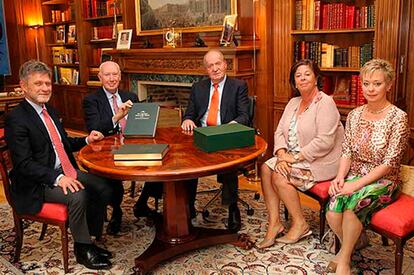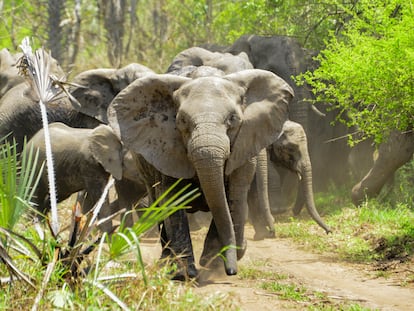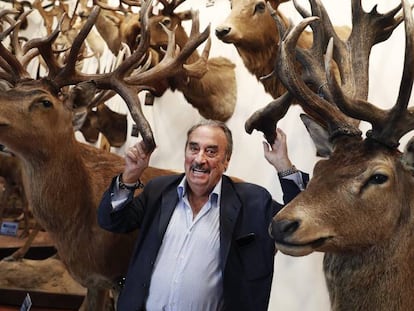Nicolás Franco donates hunting trophies from 80 countries to Spain’s National Museum of Natural Sciences
The dictator’s nephew, who claims to have met Osama bin Laden in the mountains between Afghanistan and Pakistan, is giving away the specimens he accumulated over decades

Businessman, hunter and naturalist Nicolás Franco Pasqual del Pobil, the rebellious nephew of longtime Spanish dictator Francisco Franco, has donated a collection of around 250 stuffed and mounted animals to the National Museum of Natural Sciences in Madrid. One specimen has been on display since May 25 — a magnificent Marco Polo sheep — along with an alarming warning that the subspecies is in danger due to rampant overhunting. Franco welcomed EL PAÍS for an interview in his Madrid home, nearly half a century “removed from the political noise,” to tell the story of how he collected these hunting trophies. Born in Salamanca (western Spain) 86 years ago, the avid hunter begins by telling us about the expedition he organized in 1970 to Afghanistan’s fearsome Wakhan Corridor, bordering China and the Soviet Union. “I was riding a yak along a precipice. If it stumbled, we would have fallen 100 yards to our deaths. On one side was China and on the other was the Soviet Union. We spotted two Marco Polo sheep. Bang! A single shot dropped one. Bang! Bang! Three bullets, two Marco Polos,” said Franco, the honorary president of the International Council for Game and Wildlife Conservation (CIC), a hunting organization based in Budapest (Hungary).
Nicolás Franco Pasqual del Pobil was the rebel of the family. He grew up in Estoril (Portugal) while his father, Nicolás Franco Bahamonde, served as Spain’s ambassador to Portugal. One of his friends there was a future King of Spain, Prince Juan Carlos de Borbón. In 1974, a year before the dictator’s death, the nephew of Franco secretly met with Santiago Carrillo, leader of the Spanish Communist Party, to explore a potential democratic transition with Juan Carlos de Borbón as king. With intrigue in his voice, Franco Pasqual del Pobil recalls meeting the man the Franco regime called “the devil.” Carrillo said to him over dinner at Le Vert Galant restaurant in Paris, “Well, Nicolás, as you see, I haven’t ordered any grilled children for dinner.” Franco replied, “As you see, I haven’t ordered any grilled lefties either.” In April 1975, Franco’s nephew appeared on the cover of Cambio 16 magazine with a headline that caused a stir: “Nicolás Franco wants democracy.”
There is not a single stuffed animal in the hunter’s house, and the only skin is the rug beneath his feet, made from a zebra he killed in Kenya. Thousands of books line every wall from floor to ceiling. One of them is his uncle’s diary (Diario de una bandera, 1921) of his time as an infantry commander in the Moroccan war. It’s dedicated to Nicolás with the inscription, “With affection, Uncle Paco.” It’s an unusual signature. “I don’t think he signed anything as Paco,” said the hunter. A photo on a bookshelf shows a young Nicolás in Afghanistan, standing over his freshly killed Marco Polo sheep. Another framed photo shows King Juan Carlos with a ram he just killed in Kazakhstan, and says, “To Nicolás Franco, a great hunter and my best childhood friend.”

Franco Pasqual del Pobil estimates that he has visited 121 countries, around 80 of them for hunting trips. Three-quarters of the over 250 donated specimens are bovids, but they also include a dozen types of felines and other species. The museum’s mammal collection curator, Ángel Garvía, points out a rare Indian clouded leopard in the collection. Other species include an Alaskan walrus, a South American maned wolf, an Australian dingo, a Manchurian Siberian tiger, a Persian Gazelle from Iran, a Kashmir urial sheep, a Nubian ibex from Sudan, a Gabon mouse deer, a Canadian lynx, a saiga antelope from the steppes of Mongolia and a Nile crocodile. The museum’s director, Rafael Zardoya, says it is “the largest and best donation” they have received in recent years. “It’s one of the world’s finest collections of sheep,” he said. Zardoya noted that the institution didn’t pay anything for the collection and that all specimens comply with legislation governing the international trade of endangered species.
Franco launches into another story about a chance meeting in November 1999 at a rundown border post in the Toba Kakar mountain range between Afghanistan and Pakistan. He was on a sheep-hunting expedition and stumbled upon Osama bin Laden. This was nearly two years before September 11, but Bin Laden was already a global fugitive for his role in the terrorist attacks on U.S. embassies in Africa. “We were in a shack that sold everything from car batteries to Kalashnikov rifles and Coca-Cola,” said Franco. He says the terrorist arrived escorted by half a dozen SUVs with tinted windows and sat down with his companions to have tea. Franco said he approached Bin Laden and extended his hand, saying, “Nicolás Franco, from Spain.” The most wanted man on the planet got up, shook his hand and invited him to sit down. Franco then praised the local hospitality and the beauty of the mountains. Bin Laden responded that Spain was a fraternal country and spoke of Al-Andalus, the part of the Iberian Peninsula under Muslim rule in the Middle Ages. After a while, the terrorist said, “Allah be with you,” and departed.
“It’s one of the world’s finest collections of sheep”Rafael Zardoya, director of the National Museum of Natural Sciences
CIC, the game and wildlife organization led by Nicolás Franco, promotes hunting as a “conservation tool.” The naturalist cites programs carried out by local tribal communities to save markhors in Pakistan. Wealthy hunters, often Americans, pay up to $150,000 for a permit to shoot one of these mountain goats with spectacular horns. This money is used to fund conservation activities such as anti-poaching patrols, which also provide jobs. While killing for conservation may seem repugnant and counterintuitive, it’s a strategy supported by the WWF environmental group.
Nicolás Franco is the co-author of one of the foremost reference books on Caprinae (medium-sized bovids) — the CIC Caprinae Atlas of the World. It’s a monumental tome of over 1,000 pages published a decade ago, with a prologue by his old friend, King Juan Carlos, who writes how his grandfather, King Alfonso XIII, advocated for nature preserves in Spain in the early 20th century that saved the Capra pyrenaica victoriae, a subspecies of mountain goat named in honor of his grandmother, Queen Victoria Eugenia. The prologue is signed at the Zarzuela Palace on February 27, 2013, almost a year after King Juan Carlos’ controversial trip to Botswana to hunt elephants that led to his removal as the WWF’s honorary president.

Nicolás Franco was a public prosecutor and supporter of his uncle’s regime, but abandoned politics after his death. “It’s hard to believe, but [former prime minister] Felipe González is a good friend of mine. I asked him what I should do [after the dictator’s death], and he said, ‘With your name and position, hibernate quietly.” Franco decided to focus on his business interests, which included a controlling interest in a casino in Villajoyosa (Alicante, Spain). He also served as president of Banco de Huelva, controlled by eccentric businessman, José María Ruiz Mateos.
Most of Franco’s collection is currently stored at a warehouse belonging to the National Museum of Natural Sciences. Before it comes into the museum, each specimen is checked and fumigated by technicians to get it ready for display. Many specimens cannot be exhibited because of a space shortage, says Zardoya, noting that less than 1% of the museum’s over 11 million items are on exhibit.
The institution values Franco’s collection at over €150,000 ($164,000), though the cost of the hunting trips far exceeded that amount. This type of hunting is so expensive that few can afford it, as evidenced by the Spanish Ministry of Agriculture’s list of the 50 best Spanish ibex trophies. Aristocrats and wealthy businessmen, such as Nicolás Franco, King Juan Carlos I, Juan March de la Lastra, Ignacio Sánchez Galán, and Juan Abelló Gallo feature on that list. Nicolás Franco also belongs to the Culminum Magister brotherhood of mountain hunters. The brotherhood’s motto is simple — “Silence, solitude and initiative.”
Franco and his wife, María Luisa, told us that he has donated his collection of bears and birds to the Cantabrian Nature Museum in Carrejo (northern Spain). “There is no museum in the world that has a more complete collection of bears,” said Franco. “They have rare specimens like the Andean Spectacled Bear and the Malayan Bear.” A little less than 50 years ago, the Europa Press news agency broke the news to the world at 4:58 am on November 20, 1975: “Franco has died. Franco has died. Franco has died.” The source of the news was Nicolás Franco Pasqual del Pobil, a witness to his uncle’s agonizing death in a hospital bed. A journalist asked him, “Is it over?” And the nephew replied, “Yes.”
Sign up for our weekly newsletter to get more English-language news coverage from EL PAÍS USA Edition
Tu suscripción se está usando en otro dispositivo
¿Quieres añadir otro usuario a tu suscripción?
Si continúas leyendo en este dispositivo, no se podrá leer en el otro.
FlechaTu suscripción se está usando en otro dispositivo y solo puedes acceder a EL PAÍS desde un dispositivo a la vez.
Si quieres compartir tu cuenta, cambia tu suscripción a la modalidad Premium, así podrás añadir otro usuario. Cada uno accederá con su propia cuenta de email, lo que os permitirá personalizar vuestra experiencia en EL PAÍS.
¿Tienes una suscripción de empresa? Accede aquí para contratar más cuentas.
En el caso de no saber quién está usando tu cuenta, te recomendamos cambiar tu contraseña aquí.
Si decides continuar compartiendo tu cuenta, este mensaje se mostrará en tu dispositivo y en el de la otra persona que está usando tu cuenta de forma indefinida, afectando a tu experiencia de lectura. Puedes consultar aquí los términos y condiciones de la suscripción digital.
More information
Archived In
Últimas noticias
Most viewed
- Sinaloa Cartel war is taking its toll on Los Chapitos
- Oona Chaplin: ‘I told James Cameron that I was living in a treehouse and starting a permaculture project with a friend’
- Reinhard Genzel, Nobel laureate in physics: ‘One-minute videos will never give you the truth’
- Why the price of coffee has skyrocketed: from Brazilian plantations to specialty coffee houses
- Silver prices are going crazy: This is what’s fueling the rally











































